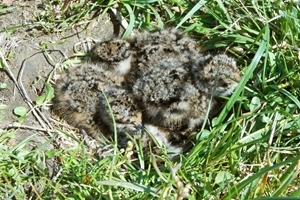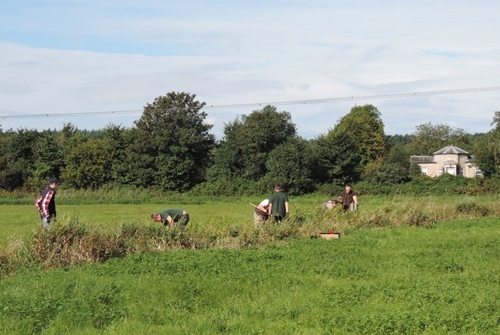Key findings
- Breeding lapwing increased from 62 pairs in 2015 to 81 pairs in 2016.
- We recorded an increase in lapwing productivity in 2016 owing to wetter field conditions and increased chick survival.
- Over both 2015 and 2016 lapwing chicks that fledged had a significantly smaller range size than those who failed.
- Habitat work is increasing the amount of in-field wet features to create more chick foraging habitat.
Initial results
 We recorded an increase in lapwing pairs from 62 in 2015 to 81 in 2016 and an increase in redshank pairs from 19 in 2015 to 28 in 2016. This is likely to have been the result of increased recruitment following a good breeding season in 2014 and wetter field conditions in spring 2016 than in 2015. Samples of 58 and 64 lapwing nests were located in 2015 and 2016 respectively, with nest survival increased above the average from years preceding the project (50% in 2015 and 45% in 2016 compared to an average of 35% for the years 2008-2014).
We recorded an increase in lapwing pairs from 62 in 2015 to 81 in 2016 and an increase in redshank pairs from 19 in 2015 to 28 in 2016. This is likely to have been the result of increased recruitment following a good breeding season in 2014 and wetter field conditions in spring 2016 than in 2015. Samples of 58 and 64 lapwing nests were located in 2015 and 2016 respectively, with nest survival increased above the average from years preceding the project (50% in 2015 and 45% in 2016 compared to an average of 35% for the years 2008-2014).
To provide reliable estimates of lapwing chick survival and information on chick movements, we radio-tagged one chick in each of 25 lapwing broods in 2015 and 27 broods in 2016. Survival to the age of fledging (35 days) was estimated at 17% in 2015 and 46% in 2016. We believe that chick survival was higher in 2016 because field conditions were wetter and broods typically had smaller ranges from where they hatched to find food and cover. Chick survival in both years was inversely related to range size, meaning the further distance travelled the more likely to be predated, hence justifying the creation of new in-field wet features in fields favoured for nesting.
Lapwings need an average productivity of 0.7 chick per pair per year to maintain stable numbers. In 2015, total productivity was 0.29 chick/pair, mainly due to high levels of chick predation. 2015 was a particularly dry year and many wet features had dried out by the time nests had hatched, so chicks had to move further to find foraging locations. In 2016, total productivity reached 0.63 chick/pair and in the core sites productivity reached 0.78 chick/pair. Nest survival was very similar for the two years, but chick survival in 2016 was dramatically higher leading to the increased productivity.

A large amount of habitat work was undertaken at one core site in autumn 2015 (1.3km old fence lines removed, 1km of willow scrub removed, 2.9km of ditches re-profiled and 1.6km of new ditches and 7 scrapes dug) and the benefits were seen in 2016, with pairs of lapwing using the site increasing from 5 to 15. Further habitat work at other sites will continue and we hope that by increasing our efforts to exclude mammalian predators though the use of nest exclusion cages and electric fences at these sites next year we will have another season of high wader productivity.